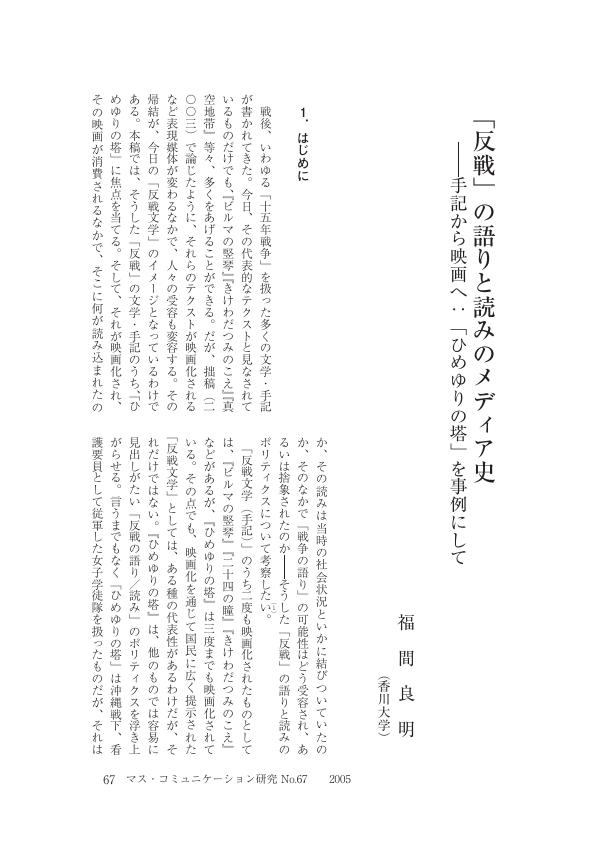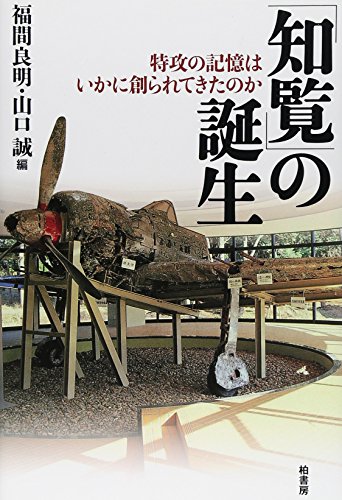32 0 0 0 現代の戦争研究と総力戦研究とを架橋する学際的戦争社会学研究領域の構築
2018年度は、5年間の研究計画の二年目であった。まず、4月14、15日に東京大学で行われた戦争社会学研究会第9回大会の場を利用して、野上は、東京大学文学部社会学教授・佐藤健二氏を招いて特別講演「「戦争と/の社会学」のために」を企画した。これもまた、学際的研究領域としての「戦争社会学」の内実を検討するものであり、活発な質疑を経て、戦争社会学の可能性を検討することができた。また西村は、テーマセッション「宗教からみる戦争」を企画した。宗教と戦争と社会の結びつきについて、多面的な議論が行われた。6月には、同研究会の研究誌『戦争社会学研究』の第二号が刊行された。特集となる「戦争映画の社会学」は、昨年度企画したシンポジウム「『野火』の戦争社会学」の活字化である。企画者の山本ほか、野上・福間が寄稿した。また、第二特集として「旧戦地に残されたもの」があり、西村が企画趣旨文を寄せている。8月12日には、京都女子大学で小林啓治『総力戦の正体』の書評会を開催した。歴史学の立場からの「戦争と社会」研究であるが分野をまたいだ議論を可能にする幅広い問題提起を行う書物であった。書評担当者の一人を野上が担ったが、「戦争と社会」研究における「総力戦」概念の重要性に照らした検討を行った。この2018年度より、筑波大学を所属機関とする非常勤研究員として木村豊氏を雇用し、研究会の事務手続きを手伝ってもらうことになった。こうした研究会の企画のほか、研究打ち合わせを12月に行い、プレ調査の実施計画を進め、科研メンバーだけのクローズドな研究会を行った。また、筑波大学大学院「歴史社会学」演習と合同で、深谷直弘『原爆を継承する実践』の書評会を筑波大学で行った。若手研究者による戦争社会学的研究の成果である。
- 著者
- 福間 良明
- 出版者
- 社会学研究会
- 雑誌
- ソシオロジ (ISSN:05841380)
- 巻号頁・発行日
- vol.59, no.3, pp.121-130, 2015
5 0 0 0 OA ポピュラー・カルチャーにおける戦争体験の断絶と継承をめぐる比較メディア論的研究
4 0 0 0 OA ソフト・パワー構築に向けたメディア文化政策の国際比較研究
- 著者
- 佐藤 卓己 渡辺 靖 植村 和秀 柴内 康文 福間 良明 青木 貞茂 本田 毅彦 赤上 裕幸 長崎 励朗 白戸 健一郎 松永 智子
- 出版者
- 京都大学
- 雑誌
- 基盤研究(B)
- 巻号頁・発行日
- 2009
情報化の先進諸国におけるメディア文化政策の展開を地域別(時系列的)、メディア別(地域横断的)に比較検討し、国民統合的な「文化政策」と情報拡散的な「メディア政策」を明確に区分する必要性を明らかにした。その上で、ソフト・パワーとしては両者を組み合わせた「メディア文化政策」の重要性が明らかになった。佐藤卓己・柴内康文・渡辺靖編『ソフトパワーとしてのメディア文化政策』を新曜社より2012年度中に上梓する。
3 0 0 0 OA 同志社大学新聞学の形成過程と展開についての歴史社会学的研究
本研究は、同志社大学における新聞学専攻の形成と展開を通して、新聞学という学知とその文化を考察した。同志社大学の「新聞学」を戦前から戦後にかけての政治学などの学問の知との関係、戦後大衆化する大学と学生の文化などから複合的に考察し、その生成と展開について検証した。特に、鶴見俊輔を始めとした新聞学専攻の教授や京都の知識人、関係者の言説の研究から、「新聞学」という学知の変遷、学生が関わる大衆文化をその社会空間や言説空間の成立と展開過程から、文献や資料、インタビュー調査などによって分析した。
3 0 0 0 OA ポピュラー・カルチャーにおける「継承」の過剰と脱歴史化
- 著者
- 福間 良明
- 出版者
- 関西社会学会
- 雑誌
- フォーラム現代社会学 (ISSN:13474057)
- 巻号頁・発行日
- vol.16, pp.104-115, 2017 (Released:2018-06-13)
- 参考文献数
- 13
本稿では、ポピュラー・カルチャーにおける「戦争の記憶」の「継承」と「断絶」のポリティクスを捉え返すべく、「特攻の町・知覧」が戦跡観光地として成立するプロセスについて、検討する。かつて陸軍特攻基地があった知覧は、交通アクセスの悪さにもかかわらず、特攻隊員の「思い」への感情移入を促す場として、近年ますます多くの観光客を集めている。だが、知覧は戦後の初期から「特攻の町」であったわけではない。さらに言えば、特攻体験は知覧住民の戦争体験ではない。特攻出撃したのは、全国各地から集められた陸軍パイロットであって、知覧の住民ではない。にもかかわらず、なぜそれが「知覧の記憶」として位置づけられ、多くの来訪者の感涙を誘うに至ったのか。こうした事例を考察することは、観光や映画を含む近年のポピュラー文化における「継承」のポリティクスを捉え返すことにもつながるだろう。本稿は「特攻の町・知覧」が創られていくプロセスを概観しながら、「継承」の語りが何を覆い隠してきたのかについて、検討する。そのうえで、これらの力学が戦後ポピュラー・カルチャーのいかなる変容を象徴するものなのかを考察する。
3 0 0 0 福間良明著 『辺境に映る日本--ナショナリティの融解と再構築』
- 著者
- 菊地 暁 福間 良明
- 出版者
- 社会学研究会
- 雑誌
- ソシオロジ (ISSN:05841380)
- 巻号頁・発行日
- vol.49, no.1, pp.175-183, 2004
3 0 0 0 OA ポピュラー・カルチャーにおける「戦争」とジェンダーに関する文化社会学的研究
ポピュラー・カルチャーのなかで形成される戦争の表象を、ジェンダーの視点から考察した。たとえば、男らしい戦争イメージの形成では、『男たちの大和』『連合艦隊』などの映画、さらに「大和ミュージアム」や知覧という観光、あるいはプラモデルなどが大きく絡んでいる。女らしさやこどもらしさについては、むしろ『ガラスのうさぎ』『火垂るの墓』などの児童書・アニメの影響が大きい。こうした点を考慮し、それぞれの戦争(沖縄戦、原爆、空襲など)が社会的に受容されるうえで主に寄与したポピュラー・カルチャーに着目し、それらを横断しながら構築される戦争イメージについて分析した。
1 0 0 0 OA ラフカディオ・ハーン研究言説における「西洋」「日本」「辺境」の表象とナショナリティ
- 著者
- 福間 良明
- 出版者
- The Japan Sociological Society
- 雑誌
- 社会学評論 (ISSN:00215414)
- 巻号頁・発行日
- vol.53, no.3, pp.329-347, 2002-12-31 (Released:2010-04-23)
- 参考文献数
- 18
本稿では, 戦前の小泉八雲研究=「ハーン学」の言説における「西洋」「日本」「辺境」の表象を分析し, 「西洋」「日本」「辺境」が交錯する場で紡がれるナショナリティを浮き彫りにする.1900年代の「ハーン学」では, 「日本」は, 「西洋」のような普遍性を希求しつつもそれが欠如したものとして認識されていたが, 次第に「西洋」に比した特殊性が強調されるようになり (1910~20年代), さらには「西洋」に代わる別の普遍性を「西洋」に向けて呈示することが志向されるようになった (1930~40年代).だが, 同時に, そのような中で, その自己像を正当化すベく, 「日本」は, 「辺境」を排除/包摂の対象として描き, また流用していった.そこでは一方で, 「西洋」からの視線, オリエンタリズムが受容され, 内面化され, つねに「西洋」に呈示されるべき自己像が意識されつつ, 他方で, そのような自己表象を成立させるために, 「辺境」の表象, 「辺境」による逆照射が不可欠だった.だが, 「日本」は「西洋」と「辺境」とに向き合う中で生産/再生産され, 強化されるだけでなく, その三者の交錯の中でナショナリティがゆらぐ契機もあった.本稿では, ハーン学言説の分析を通して, 「西洋」「辺境」という2つの他者との交渉でナショナリティが構築され, また同時にゆらぎ, その決定されざる残余が浮き彫りにされる様相を提示する.
- 著者
- 福間 良明
- 出版者
- 日本時間学会
- 雑誌
- 時間学研究 (ISSN:18820093)
- 巻号頁・発行日
- vol.7, pp.21-30, 2016 (Released:2017-05-01)
1 0 0 0 OA 広島・長崎と「記憶の場」のねじれ : 「被爆の痕跡」のポリティクス
- 著者
- 福間 良明
- 出版者
- 立命館大学人文科学研究所
- 雑誌
- 立命館大学人文科学研究所紀要 = 立命館大学人文科学研究所紀要 (ISSN:02873303)
- 巻号頁・発行日
- vol.110, pp.111-137, 2016-03
- 著者
- 福間 良明
- 出版者
- 日本マス・コミュニケーション学会
- 雑誌
- マス・コミュニケーション研究 (ISSN:13411306)
- 巻号頁・発行日
- vol.88, pp.55-74, 2016-01-31 (Released:2017-10-06)
- 参考文献数
- 18
Even today, memories of war are frequently debated and represented in media cultures, although 70 years have passed since the end of the Pacific War. Many tourists visit the war memorial sites in Hiroshima, Okinawa, Chiran, etc. Some war movies, such as Eternal Zero and The Emperor in August (the remake of Japan's Longest Day, originally produced in 1967) became big hits. We can see the desire to "succeed the memories of war" and promote harmony between generations in these popular cultures. However, do such harmonies conceal the suppression of the painful war experiences? Many people are influenced by the stories of war movies or war memorial sites; however, do these emotional impressions lead to indifference to the complicated historical facts? This study analyzes the process of the transformation of memories of war in postwar media cultures to examine the politics of representation and narratives of the war.
1 0 0 0 OA 「反戦」の語りと読みのメディア史 手記から映画へ:「ひめゆりの塔」を事例にして
- 著者
- 福間 良明
- 出版者
- 日本マス・コミュニケーション学会
- 雑誌
- マス・コミュニケーション研究 (ISSN:13411306)
- 巻号頁・発行日
- vol.67, pp.67-83, 2005-07-31 (Released:2017-10-06)
- 参考文献数
- 25
- 被引用文献数
- 1
1 0 0 0 OA 「忘却という継承」の消失 : 祝祭・遺構・モニュメント
- 著者
- 福間 良明
- 出版者
- 立命館大学国際言語文化研究所
- 雑誌
- 立命館言語文化研究 = 立命館言語文化研究 (ISSN:09157816)
- 巻号頁・発行日
- vol.25, no.2, pp.67-79, 2014-01
1 0 0 0 「知覧」の誕生 : 特攻の記憶はいかに創られてきたのか
1 0 0 0 「昭和」の記憶とメディア:特集企画の趣旨
- 著者
- 福間 良明
- 出版者
- 日本マス・コミュニケーション学会
- 雑誌
- マス・コミュニケーション研究 (ISSN:13411306)
- 巻号頁・発行日
- vol.76, pp.3-5, 2010
<p>We reached a point to look back at a history after war by passing more</p><p>than 60 years after the end of the war. Nostalgia for Showa period recently can</p><p>be the one of the example. However, while the image of nostalgic Showa period</p><p>is still alive and people comfortably recollect the past, some memory was</p><p>pushed away and some memory is meaningly selected. And then, this phenomenon</p><p>has not seen only recently.</p><p> Before the war, during the war, after the war, also Showa period, what</p><p>kind of memory has been selected and pushed away. Focusing this kind of phenomenon,</p><p>the theme of this special edition gives us some thought of the politics</p><p>of the story of Showa period.</p><p> In addition, these points are focused for the discussion among our academy.</p><p>In the spring academic meeting 2009, the title of the first symposium was" The</p><p>memory of Showa period and public opinion or popular sentiments". Also the</p><p>workshops such as" War and journalism"( media history academic project) and</p><p>"Visual image of 'the memory of war' and archive" have held under similar</p><p>theme.</p><p> This special edition has been projected including the study trends above.</p><p>6 papers in this journal have been written independently, however, we can find</p><p>out some similarity of examining of' Showa' and' the booms of Showa' in the</p><p>view point of media study and mass communication study.</p><p> I wish to activate the discussion in this field after the publication of this</p><p>special edition.</p>
- 著者
- 福間 良明
- 出版者
- 学術雑誌目次速報データベース由来
- 雑誌
- ソシオロジ (ISSN:05841380)
- 巻号頁・発行日
- vol.46, no.1, pp.37-54, 2001
This paper examines the process of the construction of the 'Peripheries' and Nationality through the text of Misao Tojyo and Motoki Tokieda.<br> Misao Tojyo was the scholar whose major was dialectology. Motoki Tokieda was the scholar of Japanese linguistics and the professor of Keijyo Imperial University in Korea before the end of the occupation of the peninsula by Japan. In their thought, it was not necessary that dialects and Korean language were definitely the Other of Japanese language. Such languages were something that made the definition or boundary of Japan/Japanese ambiguous and were going to break them. But, for that reason, Japan/Japanese was reconstructed as something that could govern the Peripheries such as dialects/the regional or Korean and the Peripheries had to be both included and excluded by Japan/Japanese.<br> On the other hand, 'the Occident (language) ' was represented as the Other - what was definitely different from Japan/Japanese - by Tojyo and Tokieda. Though Japan was threatened by the Occident in a political sense, the definition of Japan might be made more and more clear and natural in a cultural sense.<br> In the argument of Japanese linguistics before the end of the World War II (and also after it), especially in those of Misao Tojyo and Motoki Tokieda, Japan was recognized on the one hand as what was approved and made particular by the Occident that was recognized as something universal and general, and the other, it was recognized as what was universal and general by the Peripheries, so the nationalism of Japan could go across the boundary of it and be applied to the Peripheries.
- 著者
- 福間 良明
- 出版者
- 岩波書店
- 雑誌
- 思想 (ISSN:03862755)
- 巻号頁・発行日
- no.1096, pp.130-152, 2015-08
1 0 0 0 福間良明著 『辺境に映る日本--ナショナリティの融解と再構築』
- 著者
- 菊地 暁 福間 良明
- 出版者
- 社会学研究会
- 雑誌
- ソシオロジ (ISSN:05841380)
- 巻号頁・発行日
- vol.49, no.1, pp.175-183, 2004
1 0 0 0 OA 吉見俊哉著『夢の原子力――Atoms for Dream』
- 著者
- 福間 良明
- 出版者
- 日本社会学会
- 雑誌
- 社会学評論 (ISSN:00215414)
- 巻号頁・発行日
- vol.64, no.3, pp.511-513, 2013 (Released:2014-12-31)



